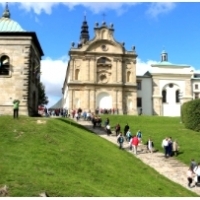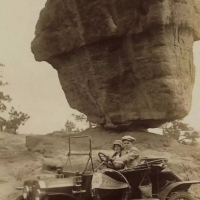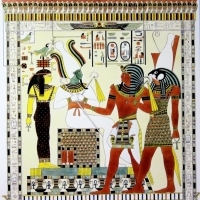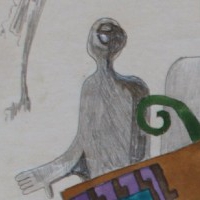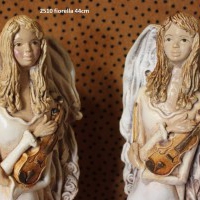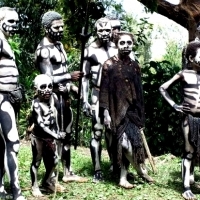Niezwykła historia Łysej Góry i starcia z Aleksandrem Wielkim. (circa 340-323 p.n.e.) LESTKO I Król Lechitów
0 : Odsłon:
Niezwykła historia Łysej Góry i starcia z Aleksandrem Wielkim. (circa 340-323 p.n.e.)
Niezwykła historia Łysej Góry i starcia z Aleksandrem Wielkim. (circa 340-323 p.n.e.)
Do dziś największą zagadką polskiej historiografii czasów przedkatolickich jest Łysa Góra. Zarówno postacie historyczne, jak i samo miejsce jest owiane niewyjaśnionymi po dziś dzień legendami. Samo miejsce nie było przedmiotem dokładniejszych badań archeologicznych. Łysą Górę otaczają dziwne informacje. Już piętnastowieczna monografia i wszystkie następne publikacje wzmiankują przeszłość kultową tego miejsca.
Według Jana Długosza :
(…) znajdować się miała bożnica w bałwochwalstwie żyjących Słowian, gdzie bożkom Lelum i Polelum ofiary czyniono i podług innych czczono tu bożyszcza: Świst, Poświst, Pogoda (…)
Z „Chorografii” Jana Długosza
„Kalwarię ponad wszystkie góry ze względu na jej rozgłos i sławę stawiam i księciem innych gór ją mianuję, jako też jest. (…) W ziemi sandomierskiej w pobliżu miasta Opatowa wznosi się góra Kalwaria, skrzepła z prawie zawsze tu panującego zimna i otoczona częstymi mgłami, deszczami i śniegami, mając w wielu miejscach pieniące się źródła. Ongiś była bardzo rozsławiona z Cyklopów (jeżeli da się wiarę dawnemu ludowemu podaniu), o czym zresztą świadczą bardzo znaczne kupy kamieni ze zrujnowanego zamku, który miano stawiać na górze. Dzisiaj zaś [jest to] siedziba klasztoru zakonników reguły świętego Benedykta. Niepewne jest, który z Cyklopów i w jakim czasie wzniósł tak potężne zamczysko, mające tak bardzo długie ściany i tak wielkie, jak na ów wiek, głazy tak olbrzymim wysiłkiem. Olbrzymiego skupiska głazów tej potwornej budowli i potężnych zwalisk ruin nie mogły zakryć ani ciernie, ani kolące zielska, ani gęste tu drzewa i mchy”.
Powieść rzeczy istey z l poł. XVI w.
Na tym też miejscu był kościół trzech bałwanów, które zwano Łada, Boda, Leli. Do których prości ludzie ludzie schadzali się pierwszego dnia maja, modły im czynić i ofiarować. Tedy Dąbrówka przerzeczona pokaziwszy ich bóżnice, kazała zbudować kościół i poświęcić ku czci i ku chwale wielebnej Świętej Trójce
Pełny tekst opisu z I poł. XVI w.:
„Dąbrówka chcąc chwałę bożą w Polszcze rozmnożyć, iakoby młode szczepie, szukaiąc mieysca godnego ku budowaniu kościoła. Spodobało się iey mieysce iedno, Lysa gora wezwane od zamku Lysiec, który na niey był, ktory też tak zwano, iż się z daleka bielał. Na tym zamku pani iedna przedtym mieszkaiąca, podniowszy sie w pychę, iż była poraziła wielkiego Alexandra pod tą gorą, kazała sie za Boginią Dianą chwalić. Ale natychmiast za tho bluźnierstwo pomstę Bożą uznała, iż on zamek wszystek grom roztrącił onę też panią ze wszystkimi służebniki pothłumił, tak iż ieszcze po dzis dzień leżą na tym mieyscu wielkie gromady kamienia. Na tym też mieyscu był Kościół trzech bałwanów, ktore zwano Lada, Boda, Leli. Do krtórych prości ludzie schadzali sie pierwszego dnia Maia, modłę im czynić y ofiarować. Tedy Dąbrówka przerzeczona pokaziwszy ich boźnice kazała zbudować kościoł y poswięcić ku czci y ku chwale wielebney świętey Troycy (…) potym klasztor wielki a sławny Krol Bolesław Chabry, na prośbę teyże Dąbrówki matki swey, ktorey był syn iedyny, roku szóstego po koronacyiey więtszym imieniem nadał y dostatkiem więtszym zmurował”.
Opis bernardyńskiego kronikarza Jana z Komorowa (ok. 1470-1536)
U podnóża Łyśca w dzisiejszej św. Katarzynie, przed pojawieniem się niejakiego Więcławka (Więcesława) miał działać:
„pewien fałszywy prorok biegły w astrologii, który mówił prostym ludziom, że jest Bogiem. Miał on Apostołów i Marię Magdalenę, zaś kościół zbudował sobie na szczycie Łysicy, pół mili od naszego klasztoru: są tam jeszcze szczątki tej drewnianej świątyni”.
„w tym swoim kościele lub raczej w przybytku bałwochwalstwa zewsząd przez prostych mieszkańców był jak Bóg czczony (…) wędrował po świecie i przepowiadał nam kiedy grady, ulewy, burze nadejdą. Krążył po wsiach cuda czyniąc (…), żywił się świeżymi rybami z wód, w których ich nigdy przedtem nie było. My zaś prości czciliśmy go jak boga.”
„wreszcie pewien podstarości z Bodzentyna przybył wraz ze swa czeladzią i trzymając w rękach dwa kije ucięte u jej podnóża, wszedł do tej kaplicy. Wówczas ów [fałszywy prorok] przemówił do niego: O nędzne stworzenie, czemuż prześladujesz swego Stwórcę? Podstarości oniemiał, słysząc tak bluźniercze słowa. Gdy zaś odzyskał śmiałość powiedział mu: Jeśli ty jesteś bogiem, tak jak mówisz, powiedz prawdziwie, który z tych dwóch kijów: ten po prawej, czy ten po lewej, jest nacięty? Tamten odpowiadając zbłądził. Wówczas podstarości poznając zwodziciela zabił go wyciągnąwszy poza kaplicę, zaś apostołowie i wszyscy, których tamten zwodził, rozbiegli się po lasach i nigdy już więcej nikt ich tam nie widział”.
Kult bóstw „Leli” wspominany jest też na Łysej Górze, obok „Łady” i „Body”, w „Powieści świętokrzyskiej” z 1538 (1550) roku:
„ na Łysej Górze był kościół trzech bałwanów,
które zwano Łado, Boda, Leli […] tedy Dobrawa,
pokaziwszy ich bożnicę, kazała zbudować kościół
ku czci św. Trójcy. Późniejsi odnosili to do r. 1006,
tj. do r. 1006,
tj. do mniemanego roku założenia klasztoru”.
Oraz w „Nowych Atenach” B. Chmielowskiego
ŁYSA GÓRA, vulgo Świętokrzyska w Sędomierskim Województwie, na której o mil 10 pod czas pogody widać Kościół i Klasztor. Był tam niegdy Polaków Asylum Forteca i Antemurał, jako z kamieni wielkich i murów trzech olim górę tę otaczających łatwo wnosić. Tam bogata mieszkając Pani, a tryumfując z Nieprzyjaciół, udała się za Dianę Boginię, od pospólstwa odbierając cultum, za to a DEO deorum piorunem zabita, według Kronik tamecznych. Tam Dąbrówka Chrześcijanka, Xiężna Polska obaliła Bałwany, Łady, Body, Leli, a Swiętej Trójcy wystawiła Kaplicę.
Funkcje kultowe
Nie wiemy jak wyglądały obrzędy poświęcone kultowi Lela i Polela na Łysej Górze. Jedyne opisy zachowane do dziś dotyczą opisów kultu w innym świętym miejscu oddalonym o ok. 400 km od Łysej Góry. Gaj Limijski znajdował się na terytoirium obecnym ziem Polski, co potafimy odczytać dzięki zapisowi dawnych danych kartograficznych na antycznej mapie z ok. 150 r.n.e i pracy naukowców z TU Berlin, którzy odcyfrowali dawne współrzędne kartograficzne. Sądząc z prac współczesnych naukowców, opis dotyczy raczej okolic Sierakowa nad Wartą.
Naharwalowie pokazuią u siebie gay, starożytnym nabożeństwem poświęconą. Strażnikiem, iego pop, w odzieniu niewieścim. Oddaią cześć bogom, iacy są w tłomaczeniu Rzymskim Kastor i Pollux, przyznaiąc im moc też samą. Nazwisko ich Alcis: nie widać żadnego posągu, ani żadnych obcych obrządków, prócz tego. że ich iako braci i młodzieńców wielbią.
”[…] sed deos interpretatione Romana Castorem Pollucemque memorant. Ea vis numini, nomen Alcis. Nulla simulacra, nullum peregrinae superstitionis vestigium; ut fratres tamen, ut iuvenes venerantur. Oddaią cześć bogom, iacy są w tłomaczeniu Rzymskim Kastor i Pollux, przyznaiąc im moc też samą. Nazwisko ich Alcis: nie widać żadnego posągu, ani żadnych obcych obrządków, prócz tego. że ich iako braci i młodzieńców wielbią.” (zahttp://www.thelatinlibrary.com/tacitus/tac.ger.shtml)
on-line: http://www.historycy.org/index.php?showtopic=17220&st=30
Natomiast W. Szafrański ( 1920-1998) archeolog i religioznawca uważał, że protoplastami polskich „Lelków” (Lel i Polel) mogli być celtyccy „Alkowie” – bóstwa lunarne związane z chtoniczną opiekunką dusz zmarłych przodków. Opierał się na relacji Tacyta, że w świętym gaju celtyckich Nahanarwalów czczono dwa bóstwa o imieniu „Alcis”, będących braćmi przypominającymi rzymskiego Kastora i Polluksa, a strażnikiem tego świętego gaju miał być kapłan w kobiecej szacie. Nie było tam żadnego posągu kultowego. W nazwie „Alcis” próbował autor doszukiwać się etymologicznego związku ze słowiańskimi bliźniętami boskimi: Lelum i Polelum. Po odrzuceniu przyrostka i końcówki zostaje bowiem rdzeń „al”, który podobno wykazywać ma pokrewieństwo z „lel”, o treści semantycznej, mającej również charakter chtoniczny, jak celtyccy Alkowie . „Lala” – córka „Łady”, lunarnej bogini płodności – oznaczała wtedy świat pozagrobowy, a bocian jako nosiciel dusz nazywany bywał „lelkiem”. „Leli” wspominane jest też na Łysej Górze, obok „Łady” i „Body”, w „Powieści świętokrzyskiej” z 1538 (1550) roku.
wg Prahistoria religii na ziemiach polskich – Strona 275, on-line: books.google.pl/books?id=mRRKAAAAIAAJ Włodzimierz Szafrański – 1987
Wały Łysogórskie
Wały na Łysej Górze miały łączną długość ok. 1,5km i wysokość dochodzącą ówcześnie do 2 metrów. Zbudowano je bez zaprawy, z ciosów kwarcytu występującego na miejscu. Budowa miała charakter otwarty, wały nie tworzyły formy obronnej. W okresie1956-1960 Instytut Historii Kultury Materialnej PAN prowadził badania wału na Łysej Górze i na podstawie resztek ceramiki datował go VIII w.
Znaleziska opisywane w miejscowej literaturze
Przeglądając miejscowe publikacje można natknąć się na następujące wzmianki: „Kroniki podają, że w 1686 roku, w czasie kucia skały w pobliżu kościoła na Św. Krzyżu, znaleziono bożyszcze dawne węglem obsypane.” lub „Ciekawą wzmiankę umieścił O. Jabłoński pod rokiem 1686: Przed drzwiami kościoła naszego w boku skalę kując, trafunkiem napadli na miejsce, w którym znaleziono bożyszcze dawne węglami osypane” (por. http://www.swietykrzyz.pl/kategorie/czasy_przedhistoryczne )
Ośrodek władzy
Istnieją doniesienia na temat „zamku”. Miał to być ośrodek władzy, który miał istnieć w czasach przedkatolickich. „Powiest Rzeczy Istej” z XV w. opisuje historię łysogórskiego zamku, oraz królowej, która „uniesiona pychą” żądała swojej deifikacji jako Diana. Co ciekawe, legendy są zbieżne i donoszą o pokonaniu w tej okolicy wojsk Aleksandra Wielkiego (ur. 19-20 lipca 356 p.n.e. w Pelli, zm. 10 czerwca 323 p.n.e. w Babilonie). W polskich kronikach historycznych znajdziemy ustęp opisujący historię etymologicznie pasującą do podanej charakterystyki zdarzenia. Podajemy ją w 2 wersjach: z Kroniki Kadłubka oraz z XII-wiecznej Kroniki Dzierzwy.
Nie mając innych danych jak zawartość owego dzieła – XII- wieczną kronikię Dzierzwy, ową historię musimy datować tak jak wskazał jej autor. Są to wg niego historie starożytne, sprzed rządów Gajusza Juliusza Cezara (objął władzę ok. 60 r.p.n.e., zakończył ją 15 marca 44 r.p.n.e.). Według Kadłubka po śmierci królowej Wandy kraj Lechitów został najechany przez Aleksandra Wielkiego[1]. Wojska macedońskie wkroczyły do Polski od strony Moraw, zajmując Małopolskę i Śląsk. Ostatecznie Aleksander miał zostać pokonany w bitwie pod górą[2], (wg późniejszego o ok. 350 lat Marcina Bielskiego była to Łysa Góra lub Łysiec) kiedyto Lechici za namową pewnego złotnika przygotowali zasadzkę na Macedończyków, zwabiając ich doń wyrzeźbionymi z drewna figurami rycerzy udającymi wojsko. Gdy pokonany Aleksander wycofał się z kraju Polan, złotnik został obwołany królem i otrzymał imię Lestek, co znaczy przebiegły.
Kronika polska, przez Dzierswę w końcu wieku XII. napisana: Z dodatkiem … Autorzy Dzierswa
Mitologia
W dość dziwnej publikacji, będącej dośc frywolną kompilacją różnych źródeł z wyraźnym sentymentem propogańskim, odkryłem zagadkową historię. Autor, fan mitologii słowiańskiej, sugeruje że na Łysej Górze w województwie świętokrzyskim znajdowały się największe świątynie pogańskie między Odrą i Wisłą. Na potwierdzenie tej opinii przytacza lokalne legendy.
Historie o Łysej Górze w Polsce
The extraordinary history of Łysa Góra and the clashes with Alexander the Great (ca. 340-323 BCE)
To this day, the greatest mystery of Polish historiography of pre-Catholic times is Łysa Góra. Both historical figures and the place itself are shrouded in legends that have not been explained to this day. The place itself has not been the subject of more detailed archaeological research. Lysa Góra is surrounded by strange information. The fifteenth-century monograph and all subsequent publications mention the cult past of this place.
According to Jan Długosz:
(...) there was supposed to be a synagogue in the idolatry of living Slavs, where sacrifices were made to the idols of Lelum and Polelum and the idol was worshiped here according to others: Swist, Poświst, Weather (...)
From Jan Długosz's "Chorography"
“Calvary above all mountains because of its fame and fame I make it the prince of other mountains, as it is. (...) In the Sandomierz region near the city of Opatów rises Mount Kalwaria, solidified from the almost always prevailing cold here, surrounded by frequent mists, rains and snow, with foaming springs in many places. Once upon a time it was very famous for the Cyclops (if one can believe the old folk tale), as evidenced by the very large piles of stones from the ruined castle, which were to be erected on the mountain. Today [it is] the seat of the monastic convent of Saint Benedict. It is uncertain which of the Cyclops and at what time he built such a huge castle, with very long walls and as big for that age, boulders with such enormous effort. The huge concentration of boulders of this monstrous structure and the huge pile of ruins could not be covered by thorns, or thorns of weeds, or trees and mosses thick here ”.
A novel of things from the 1st half of the 19th century Sixteenth century
In this place there was also a church of three idols called Łada, Boda, Leli. To which simple people descended on the first day of May, do them prayers and offer them. Then Dąbrówka, the redeemed, showed their synagogues, had a church built and consecrated to the honor and glory of the Reverend Holy Trinity
Full text of the description from the first half of 16th century:
“Dąbrówka, wanting to multiply the glory of God in Poland, and as if it were young, looking for a town worthy of building a church. I like mieyska iedno, Lysa gora called from the Lysiec castle, which was there, which was also called, that it was white from a distance. In this castle the lady who lived before, aroused with pride that she had struck the great Alexander under this mountain, ordered to be praised after Goddess Diana. But immediately for the blasphemy of the vengeance of God she found that he had smashed all thunders in the castle, and had smashed the lady with all the servants, so that still to this day there are great clusters of stone on this place. There was also a Church of three idols in this town called Lada, Boda, Leli. Until simple people gathered on the first day of Maia, I prayed to them and offered them. Then Dąbrówka, the redeemed, having shown their synagogues, ordered to build churches and consecrate to the glory of Saint Troitsa (...) then the great monastery and the famous King Bolesław Chabry, at the request of his mother Dąbrówka, who was the son of the father of the sixth year after the coronation he has built up more abundant ”.
Description of the Bernardine chronicler John of Komorów (ca. 1470-1536)
At the foot of Łysiec in today's St. Katarzyna, before a certain Więcławek (Więcesław) appeared, he was supposed to act:
“A certain false prophet skilled in astrology who told common people that he was God. He had the Apostles and Mary Magdalene, and he built a church for himself on the top of Łysica, half a mile from our monastery: there are still remains of this wooden temple. "
“In his church, or rather in the tabernacle of idolatry, he was worshiped on all sides by the common people (...) he wandered around the world and foretold us when hail, downpours, storms would come. He circled the villages, working miracles (...), he fed himself on fresh fish from waters in which they had never been present before. And we simply worshiped him as a god. "
“Finally, a certain eldership from Bodzentyn came with his domestics and, holding in his hands two sticks cut at its foot, he entered this chapel. Then the [false prophet] said to him: O you wretched creature, why do you persecute your Maker? The sub-elders were speechless at such blasphemous words. But when he regained his courage, he said to him: If you are a god, as you say, tell truthfully which of the two sticks, the one on the right or the one on the left, is cut? The other went astray in reply. Then, knowing the deceiver, he killed him, dragging him out of the chapel, and the apostles and all who were deceived by that deceiver ran into the woods, and no one saw them there again. "
The worship of the deities of "Lela" is also mentioned on Łysa Góra, next to "Łada" and "Body", in the "Święto Świętokrzyska" from 1538 (1550):
"On Łysa Góra there was a church of three idols,
which were called Łado, Boda, Leli ... then Dobrawa,
showing their synagogue, she ordered to build a church
in honor of St. Trinity. Later referred it to the year 1006,
i.e. to year. 1006,
ie until the presumed year of foundation of the monastery ”.
And in "Nowe Athens" by B. Chmielowski
ŁYSA GÓRA, vulgo Świętokrzyska in Sędomierskie Province, where the Church and Monastery can be seen at 10 miles during the weather. The Poles of Asylum Fortress and Antemurał used to be there, as it is easy to raise the surrounding mountain from the great stones and the walls of the three olim. The rich Lady lived there, and triumphed over her enemies, she went for Diana the Goddess, taking away the cultum from the masses, and killed the DEO deorum by lightning, according to the chronicles of that time. There, Dąbrówka Christian, Xiężna Polska overthrew Bałwy, Łady, Body, Leli and erected the Holy Trinity Chapel.
Iconic Features
We do not know what the rituals devoted to the cult of Lel and Polel on Łysa Góra looked like. The only descriptions preserved to this day concern descriptions of a cult in another holy place, approx. 400 km from Łysa Góra. Gaj Limijski was located in the territory of the present Polish lands, which we can read thanks to the record of old cartographic data on an ancient map from around 150 AD and the work of scientists from TU Berlin, who deciphered the old cartographic coordinates. Judging from the works of contemporary scientists, the description relates rather to the vicinity of Sieraków on the Warta River.
The Naharvals will show the gay, ancient devotion at home. The guardian, and his pop, in woman's clothing. They will worship the gods that are in the Roman translation of Castor and Pollux, giving them power too. Their name is Alcis: no statue to be seen, no foreign rituals but this. that they adore them as brothers and young men.
”[…] Sed deos interpretatione Romana Castorem Pollucemque memorant. Ea vis numini, nomen Alcis. Nulla simulacra, nullum peregrinae superstitionis vestigium; ut fratres tamen, ut iuvenes venerantur. They will worship the gods that are in the Roman translation of Castor and Pollux, giving them power too. Their name is Alcis: no statue to be seen, no foreign rituals but this. that they adore them as brothers and young men. " (zahttp: //www.thelatinlibrary.com/tacitus/tac.ger.shtml)
on-line: http://www.historycy.org/index.php?showtopic=17220&st=30
On the other hand, W. Szafrański (1920-1998), an archaeologist and religious scholar, believed that the ancestors of the Polish "Lelki" (Lel and Polel) could be Celtic "Alks" - lunar deities associated with the chthonic protector of the souls of their deceased ancestors. He relied on Tacitus's account that in the sacred grove of the Celtic Nahanarvals two deities named "Alcis" were worshiped, who were brothers resembling the Roman Castor and Pollux, and that the guardian of this sacred grove was to be a priest in a female robe. There was no iconic statue there. In the name "Alcis" the author tried to find an etymological connection with the Slavic divine twins: Lelum and Polelum. After rejecting the suffix and the ending, the root "al" is left, which is said to be related to "lel", with a semantic content, also having a chthonic character, like the Celtic alcos. "Lala" - the daughter of "Lada", the lunar goddess of fertility - then meant the afterlife, and the stork, as a carrier of souls, was sometimes called a "bird". "Leli" is also mentioned on Łysa Góra, next to "Łada" and "Body", in "The Holy Cross novel" from 1538 (1550).
according to Prehistory of religion in Poland - Page 275, on-line: books.google.pl/books?id=mRRKAAAAIAAJ Włodzimierz Szafrański - 1987
Łysogórskie Embankments
The embankments on Łysa Góra had a total length of approx. 1.5 km and a height of up to 2 meters at that time. They were built without mortar, from the blows of quartzite present on the spot. The construction was open, the ramparts did not form a defensive form. In the period 1956-1960, the Institute of the History of Material Culture of the Polish Academy of Sciences conducted research on the embankment on Łysa Góra and dated it in the 8th century on the basis of the remains of ceramics.
Finds reported in local literature
While browsing the local publications, one can come across the following mentions: "The chronicles say that in 1686, during the forging of the rock near the church on Św. Krzyż, the ancient idols strewn with coal were found. " or "An interesting mention was made by Father Jabłoński in 1686: In front of the door of our church, they stabbed a scale on the side of our church, they attacked the place where old idols covered with coal were found, by chance" (see http://www.swietykrzyz.pl/kategorie/yszne_przedhistoryczne )
The center of power
There are reports of a "castle". It was supposed to be a center of power that was supposed to exist in pre-Catholic times. The "Novel of Things" from the 15th century describes the history of the Łysogóra castle and the queen who "carried with pride" demanded her deification as Diana. Interestingly, the legends coincide and report the defeat of the troops of Alexander the Great in this area (born July 19-20, 356 BCE in Pella, died June 10, 323 BCE in Babylon). In Polish historical chronicles, we can find a section describing the history etymologically matching the given description of the event. We present it in 2 versions: from the Kronika Kadłubek and from the 12th-century Chronicle of Dzierzwa.
Having no data other than the content of this work - the 12th-century chronicle of Dzierzwa, we must date this history as indicated by its author. According to him, these are ancient stories, before the reign of Gaius Julius
Having no data other than the content of this work - the 12th-century chronicle of Dzierzwa, we must date this history as indicated by its author. According to him, these are ancient stories, from before the reign of Gaius Julius Caesar (he took power around 60 BCE, he ended it on March 15, 44 BCE). According to Kadłubek, after the death of Queen Wanda, the country of Lechites was invaded by Alexander the Great [1]. Macedonian troops entered Poland from Moravia, occupying Lesser Poland and Silesia. Ultimately, Aleksander was to be defeated in the Battle of the Mountain [2], (according to Marcin Bielski, who was about 350 years later, it was Łysa Góra or Łysiec), when the Lechites, at the instigation of a goldsmith, prepared an ambush for Macedonians, luring them with figures of knights carved from wood pretending to be army. When the defeated Aleksander withdrew from the country of Polan, the goldsmith was proclaimed king and received the name Lestek, which means cunning.
Polish chronicle, by Dzierswa at the end of the 12th century. written: With an addition ... Authors of Dzierswa
Mythology
In a rather strange publication, which is a rather frivolous compilation of various sources with a clear pro-pagan sentiment, I discovered a puzzling story. The author, a fan of Slavic mythology, suggests that on Łysa Góra in the Świętokrzyskie Voivodeship there were the largest pagan temples between the Odra and the Vistula. To confirm this opinion, he cites local legends.
Stories about Łysa Góra in Poland
The Crypts of the Slavic Kings in Łysa Góra
Łysa Góra. Polska.
: Wyślij Wiadomość.
Przetłumacz ten tekst na 91 języków
: Podobne ogłoszenia.
7 পাঠ্য আচরণ যা বিষাক্ত সম্পর্কের সিগন্যাল দেয়: সম্পর্কের লাল পতাকাগুলির মধ্যে দম্পতিদের মধ্যে বিষাক্ত পাঠ্য আচরণের আচরণ:
7 পাঠ্য আচরণ যা বিষাক্ত সম্পর্কের সিগন্যাল দেয়: সম্পর্কের লাল পতাকাগুলির মধ্যে দম্পতিদের মধ্যে বিষাক্ত পাঠ্য আচরণের আচরণ: আপনি আপনার স্মার্টফোনটি প্রতি দ্বিতীয় সেকেন্ডে চেক করে চালিয়ে যাচ্ছেন কারণ আপনার বন্ধুরা খেয়াল করছেন যে আপনি স্বাভাবিকের চেয়ে…
5621AVA. Asta C + Клеточное омоложение. Сыворотка для лица. Asta C + Zelluläre Verjüngung. Serum für das Gesicht.
Asta C + Клеточное омоложение. Код по каталогу / индекс: 5621AVA. Категория: Asta C +, Косметика действие антиоксидант, отшелушивание, лифтинг, увлажнение, омоложение, улучшение цвета, разглаживание судьба сыворотка Тип косметики гелевая сыворотка…
NITROCHEM. Firma. Produkty chemiczne.
Tradycja Zakładów Chemicznych „NITRO-CHEM” rozpoczęła się w 1948 roku, kiedy w Bydgoszczy uruchomiono produkcję trotylu. Dziesięć lat później powstały Zakłady Chemiczne. Jednym z przedmiotów ich działalności była produkcja materiałów wybuchowych.…
Elvira HORTON. HURRY, this FREE offer won’t last long! GET THIS BRAND NEW “KETOGENIC DIET COOKBOOK” FREE!
HURRY, this FREE offer won’t last long! GET THIS BRAND NEW “KETOGENIC DIET COOKBOOK” FREE! INTRODUCTION TO THE KETO DIET Discover what ketosis is, what the Keto Diet looks like, and how to induce ketosis in your body so you start burning fat (instead…
Cara infeksi influenza lan komplikasi: Cara nglindhungi virus:
Cara infeksi influenza lan komplikasi: Cara nglindhungi virus: Virus influenza dhewe dipérang dadi telung jinis, A, B lan C, yaiku manungsa umume kena infeksi A lan B. Jenis sing paling umum, gumantung saka protein khusus ing permukaan virus, dipérang…
Kurtka męska do biegania
: : : : : : : : : : : : : : : : : : : : : : : : : : : : : : : : : : : : : : : : : : : : : : : : : Opis. : : : : : : : : : : : : : : : : : : : : : : : : : : : : : : : : : : : : : : : : : : : : : : : : : DETALE HANDLOWE: : Kraj: ( Polska ) : Zasięg…
CLASSIC MEBLE. Produkcja. Meble, meble pokojowe.
Jakość, elegancja, nowoczesność to dewiza CLASSIC MEBLE. Budowanie marki i doświadczenie zawodowe zdobywane od 1986 roku pielęgnuje już drugie pokolenie rodziny Skiba. Kolejne lata to czas intensywnego rozwoju i przemian, które pozwoliły na stabilną,…
According to the Chaldean description of Genesis.
According to the Chaldean description of Genesis. "... the great gods made a dwelling for them (the people). In the middle of the earth they grew up and became great, and the number increased, Seven kings, brothers from the same family ..." Iranian,…
Przepis od doktora Krzysztof Bielecki, który aktywuje regenerację chrząstek, kości i więzadeł, przywracając stawy do stanu 20 lat!
Każdy, kto wypróbował metodę na sobie – udało mu się w pełni odbudować chrząstki i odzyskać swobodę ruchu bez bólu i dyskomfortu. A takich ludzi są tysiące! Przepis od doktora Krzysztof Bielecki, który aktywuje regenerację chrząstek, kości i więzadeł,…
10 znaków, że randkujesz z facetem niedostępnym emocjonalnie:
10 znaków, że randkujesz z facetem niedostępnym emocjonalnie: Wszyscy szukamy kogoś, kto kocha nas bezwarunkowo i na zawsze, prawda? Chociaż perspektywa zakochania i bycia kochanym może sprawić, że poczujesz motyle w żołądku, musisz upewnić się, że nie…
Olejki eteryczne na bogactwo.
Olejki eteryczne na bogactwo. Ale znając właściwości różnych olejków, możesz je wykorzystać, aby dodać sobie pewności siebie i kreatywności, rozwinąć zdolności twórcze, zwiększyć poziom aktywności, skoncentrować się na swoich celach itp. OLEJEK…
Kineski virus. Koji su simptomi koronavirusa? Šta je koronavirus i gdje se pojavljuje? Covid-19:
Kineski virus. Koji su simptomi koronavirusa? Šta je koronavirus i gdje se pojavljuje? Covid-19: Koronavirus ubija u Kini. Vlasti su uvele blokadu grada od 11 miliona - Wuhan. Trenutno nije moguće ući i napustiti grad. Javni prevoz, uključujući letove i…
Wieszak drewniany na klucze, domki ozdobne. D041. Hölzerner Schlüsselhänger, dekorative Häuser. Wooden key hanger, decorative houses.
: DETALE HANDLOWE: W przypadku sprzedaży detalicznej, podana tutaj cena i usługa paczkowa 4 EUR za paczkę 30 kg dla krajowej Polski. (Obowiązuje następująca: ilość x cena + 4 EUR = całkowita kwota za przelew) Przelewy mogą być realizowane bezpośrednio na…
Just happened: US shot down cylindrical UFO off Alaska Coast.
Just happened: US shot down cylindrical UFO off Alaska Coast. Friday, February 10, 2023 According to reports, a U.S. F-22 fighter jet shot down an unidentified object flying high over Alaska on February 10th, 2023. The object was described as…
Młoda para jedzie przy Balanced Rock w Ogrodzie Bogów w Kolorado Springs, lata 20. XX wieku.
Młoda para jedzie przy Balanced Rock w Ogrodzie Bogów w Kolorado Springs, lata 20. XX wieku.
CHALTER. Producent. Perfumy.
Jako producent perfum poszukujemy hurtowni zainteresowanych współpracą z nami w celu dystrybucji kosmetyków. Do współpracy zachęcamy wszystkie hurtownie kosmetyczne, jak również firmy i osoby prywatne chcące poszerzyć spektrum swojej działalności Co…
Feathery - a panacea from ... a window sill! pinnate, plant raw materials, herbal medicine: Nagasaki, Hiroshima, prostate, acne
Feathery - a panacea from ... a window sill! pinnate, plant raw materials, herbal medicine: Nagasaki, Hiroshima, prostate, acne Is this a real hit or an overrated weed? What can it offer us? Pinnate is currently experiencing its five minutes. And rightly…
Wir haben einen Kandidaten für den COVID-19-Impfstoff, klinische Studien, Coronavirus, Sars-Cov-2, Covid-19, Impfstoff, Johnson & Johnson:
Wir haben einen Kandidaten für den COVID-19-Impfstoff, klinische Studien, Coronavirus, Sars-Cov-2, Covid-19, Impfstoff, Johnson & Johnson: Wir haben einen Kandidaten für den COVID-19-Impfstoff, die Zusammenarbeit, BARDA, klinische Studien, Janssen,…
T-shirt męski koszulka
: : : : : : : : : : : : : : : : : : : : : : : : : : : : : : : : : : : : : : : : : : : : : : : : : Opis. : : : : : : : : : : : : : : : : : : : : : : : : : : : : : : : : : : : : : : : : : : : : : : : : : DETALE HANDLOWE: : Kraj: ( Polska ) : Zasięg…
Jeśli bierzemy cudze jedzenie, naruszamy Prawo Zgodności Ekologicznej - to podstawowe prawo Natury.
ODŻYWIANIE (porada syberyjskiej zielarki L.N. Suriny) Teraz jesteśmy chorzy, bo jemy dużo cudzych produktów: importujemy 65% cudzego mięsa, importujemy banany, pomarańcze itp. Tylko 10% cudzego jedzenia to do przyjęcia, ale 90% powinno być własne. Jeśli…
CANTANIGROUP. Producent. Silniki elektryczne.
Grupa Cantoni została pionierem w produkcji silników elektrycznych już w XIX wieku i od tego czasu kontynuuje misję wdrażania innowacyjnych technologii i nowoczesnych produktów. Przez ponad 100 lat działalności Grupa osiągnęła znaczące sukcesy na rynkach…
AMBITION. Produkty. Sztućce. Naczynia żaroodporne.
Ambiton to polska marka, w 2004 r. zadebiutowała znakomitymi sztućcami z wysokogatunkowej stali nierdzewnej. Sztućce obiadowe zaprezentowane zostały w dwóch liniach: dynamicznej, a jednocześnie klasycznej Napoli, przywodzącej na myśl powiew wiatru i fale…
Kim są Lightworkers?.⠀
Kim są Lightworkers?.⠀ Lightworkers to dusze, które mają silne wewnętrzne pragnienie szerzenia Światła (wiedzy, wolności i miłości) na Ziemi. Uważają to za swoją misję.⠀ To dusze, które często pociąga duchowość i jakiś rodzaj pracy terapeutycznej. Ze…
Kostka Rubika.
Kostka Rubika. ( gra wynaleziona przez węgierskiego wynalazcę nazwiskiem Rubik w latach 1970-tych.) Jak ustawić kostkę Rubika ,aby wszytskie kolory pojawiły się na swoich scianach? Jest na to prosty algorytm:, 9 razy powtarzamy cykl przekręcania…
Капілярная скура: сыход за тварам і касметыка для скуры капіляраў.
Капілярная скура: сыход за тварам і касметыка для скуры капіляраў. Капіляры, як правіла, разрываюць крывяносныя пасудзіны, што прымушае іх чырванець. Эфектыўная касметыка для капіляраў, напрыклад, крэм для асобы або ачышчальная пена, утрымлівае рэчывы,…
Przyjrzyjmy się demografii tamtych czasów!
Wiadomo, ze w drugiej połowie XIX wieku na całym świecie nastąpiła pewna fala niesamowitego zniszczenia miast, czego nie można wytłumaczyć poziomem dostępnej wówczas broni (oficjalnie). Cóż, historia opowiada nam o rewolucjach i pożarach. Przyjrzyjmy się…


